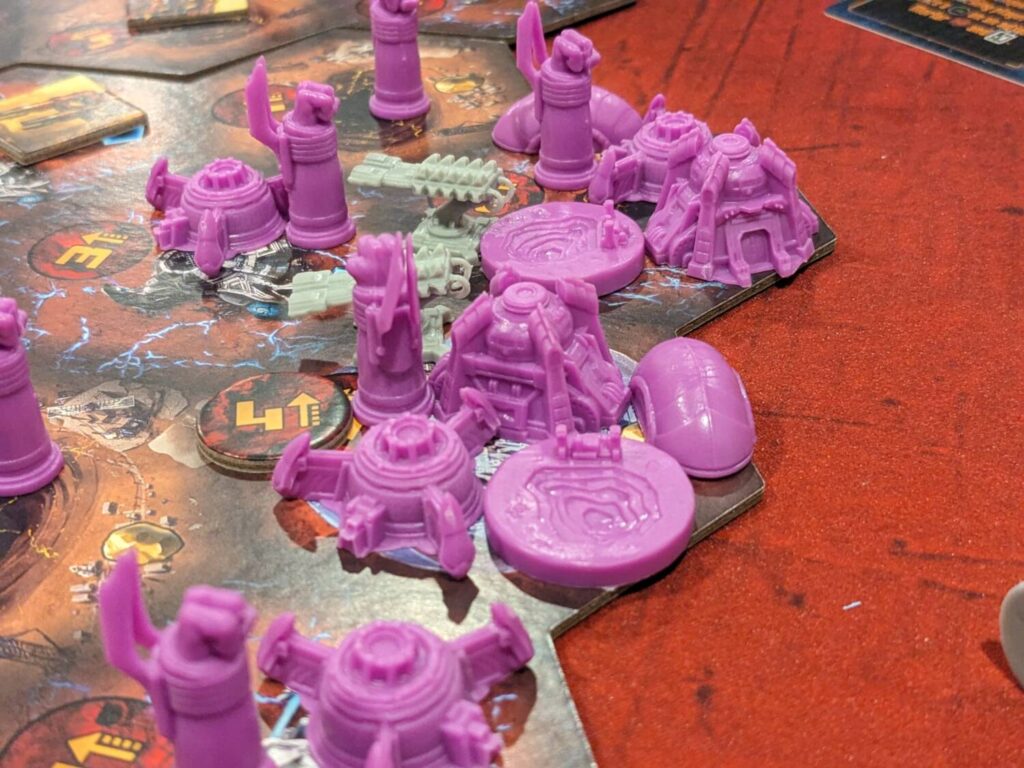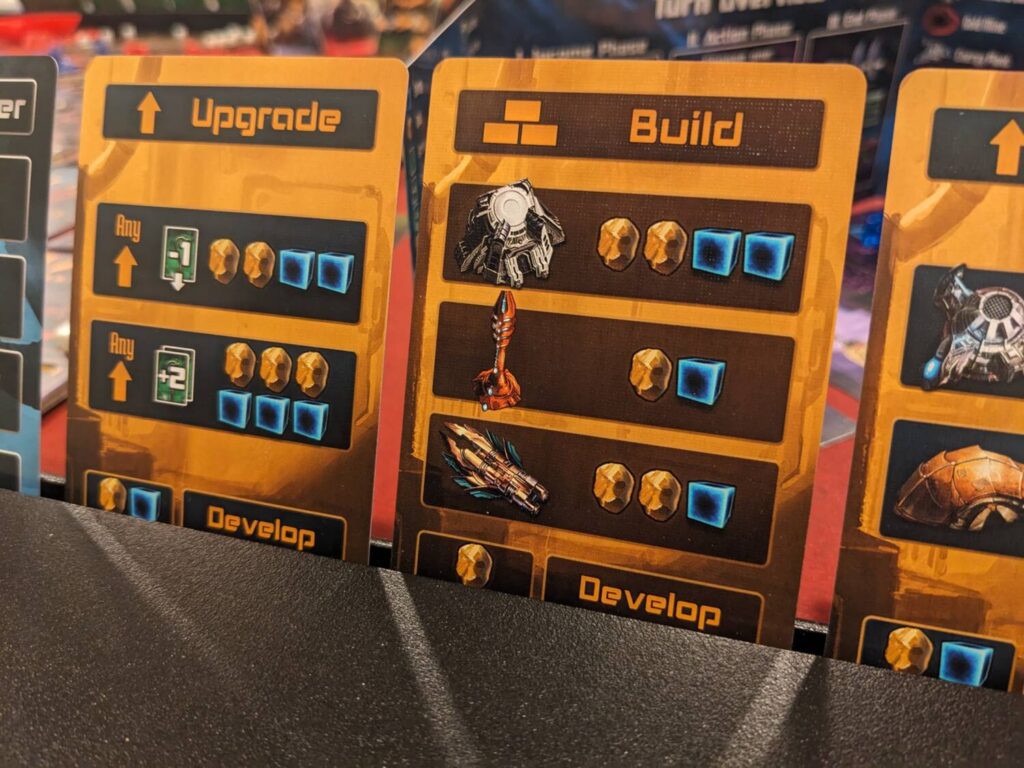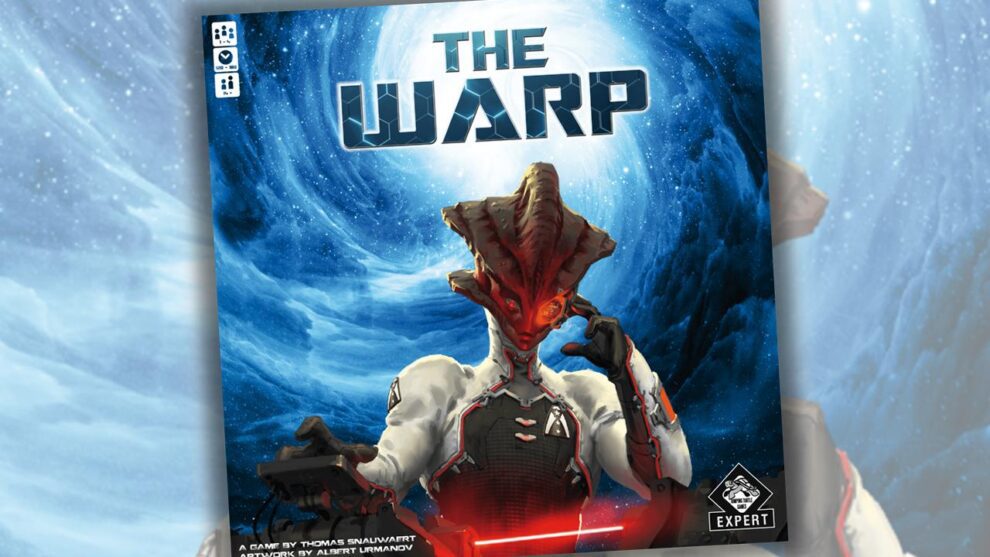Disclosure: Meeple Mountain received a free copy of this product in exchange for an honest, unbiased review. This review is not intended to be an endorsement.
At last year’s SPIEL event in Essen, Germany, I had the chance to try The Warp, a game I followed during its crowdfunding campaign because I was intrigued by its approach to the 4X genre of spacefaring adventure games (eXplore, eXpand, eXploit, eXterminate). The campaign, which ended in late 2020, gave me the sense that there would be a real chance at being blown off the map, so the “eXterminate” portion of the 4X mechanic here looked real…and many games in this category do not really follow through on that promise.
I’ve now played The Warp in both three-player and four-player arrangements, and after these plays and a promising demo back in Germany, I know that The Warp does a lot of things well, particularly in the way objective scoring takes place. While it falls a tier below the best 4X and 4X-adjacent games I have played, such as Voidfall, Scythe, Circadians: Chaos Order and Eclipse: Second Dawn for the Galaxy, I think The Warp delivers on many fronts.
The real challenge? Finding it, especially if you live in North America.

“Do You Want to Follow?”
The Warp is a relatively rules-light, 1-4 player area control and hand management experience that can be played like a Euro or a wargame or a combination of both.
Players take on the role of a faction made up of two alien species that have partnered to lead colonies to a path that will lead to the most victory points. (There is some additional backstory used to build space drama, but it didn’t really hook me.) When one player has earned nine or more VPs, the game lasts three more turns and players get the chance to close out their affairs by going for one last land grab or one more annihilation of a neighboring faction.
The two alien species are drafted from a pool of 16 different factions in the base game. These species don’t even have a backstory in The Warp, which I appreciated a great deal. Sometimes I like a rich backstory, but only if everyone is committed to going all-in (i.e., anything done by Mindclash).
Here? I just need cool pictures and clear direction on what each alien’s superpower is, and The Warp lays this out quite well. The marriage of various player advantages is a blast and is one of the real highlights of the design. It sounds cliché, but no two games of The Warp will ever be the same, especially if you are armed with the Warp Pack expansion that includes additional factions.
I mentioned the term “rules-light” because many, if not most, 4X games have a rulebook that can run for 30 pages or more. The Warp avoids this by keeping actions and edge cases quite limited. In fact, the game can be taught using the rules summary on the back of the rulebook, or by using the player screens included for each faction.
Each player’s turn is straightforward: collect income and new Archive cards, take one action, then move up to two units around the map between legal hexes and purchase new private goal cards if eligible.
The Warp also nails one of my main issues with games like Eclipse: downtime. That’s because there often isn’t any!
After a player collects income, based on the level of their progress on various tracks on their personal player board, they draw two cards from a market that grant the ability to build new buildings, upgrade those buildings, or have clever secondary abilities during combat. That’s quick. Then, players can choose one of three actions: develop (build/upgrade) their colony, terrashift different hexes to provide combat benefits, or attack another faction (either a human player or an “Exiled” faction, represented by a chit that was placed in empty hexes during setup).
Two of those three actions allow all other players to follow (take the same action), with the active player benefiting by receiving resources or cards from the supply for each player that decides to follow. This gives The Warp some of those Race for the Galaxy / Puerto Rico / Earth vibes, so that all players have a chance to do something meaningful between their own turns as the active player.

Watch Out For That Laser Cannon
Combat is going to be the lynchpin for whether players feel The Warp works or not. That’s because the combat system is mostly tied to chucking dice. [camera cuts to Justin as he watches 40% of readers and a third of our own writers scurry away from this article]
To its credit, The Warp does give a sizable advantage to the player who holds the better territory when combat begins, so holding the higher ground is important and something that can be planned before initiating a fight. Still, it was shocking how often players lost a combat when their opponent had lower ground, less troops, or less combat bonuses when entering the fray.
Just know that this is a thing in The Warp, OK? Voidfall has completely deterministic combat; Eclipse does not. Circadians: Chaos Order has mostly deterministic combat, then it allows a player to play a combat card that may or may not edge the disadvantaged party to victory, similar to Scythe. The Warp reminded one of my review crew members of the classic wargame Risk, but The Warp is elevated by the literal elevation of the territory on which battles will be fought.
Beyond the dice chucking, I really liked how designer Thomas Snauwaert built his combat engine. Players can play a combat card, or not. Attackers can bribe their opponent to remove the played combat card, if a defender decides to play one (or not offer a bribe at all). Opponents cannot negotiate the bribe, only able to choose to accept the bribe or not. There is no “ball fake” move in The Warp—if you want to play a combat card, you’ve got to play an actual combat card (facedown). Players can only attack from one hex to another, so you can’t surround a territory and bring in a unit or two from each surrounding hex.
Once combat begins, the affair is very straightforward, even if it can ultimately be a bit random. Winners of human-to-human combat gain a reward card that they can use to get an immediate bonus or an additional alien power from one of their two starting alien factions. If a faction not involved in a fight against the neutral/Exiled forces wants to help out, they can play a combat card on behalf of the Exiled faction…and if the Exiles win, the supporting faction gets two reward cards instead of one, so there’s always a reason to fight for the AI.
Defending forces that lose a fight are wiped off the battle location and not allowed to retreat. I love this. Too many 4X games give us a battle system that feels soft, and knowing that the loser (at least, if they were the defender) will lose everything gives the whole affair real teeth. Attackers actually get off easy when losing a fight in The Warp—they lose one troop/unit and have to retreat the rest to the hex that served as the point of entry. It’s all very easy to follow and lends itself nicely to interesting strategies.
If you don’t like to chuck dice to win combat, you also won’t enjoy the fact that laser cannons also require a die roll. Laser cannons, which can be activated with a free action and have a two-hex range to help kill off opposing troops before sending in your forces, require a roll value of a 4, 5, or 6 (on a normal six-sided die) to kill a unit. I was shocked by how often I used laser cannons specifically to keep the hordes away from my colony and not start a combat, only to come up empty on my die rolls.

It’s Good, But There’s Room to Grow
The Warp’s biggest sin, according to my play groups? That The Warp is not Voidfall.
I played Voidfall a bunch last year—14 times!—and it outshines The Warp in most ways a 4X game can. For my 4X money, Voidfall is hard to beat. But where The Warp and Voidfall do their best work is in the dynamic nature of their respective scoring systems. Voidfall’s scoring rules are chosen by individual factions. Personal goals (agendas) are drafted and added to starting agendas to build out that game’s scoring rules for a player. Add that to the public goals everyone can score in a round, and each game of Voidfall looks quite different.
The Warp does scoring equally well. There are a half-dozen public objectives that serve as a Euro-style milestone race for everyone. There are also three face-up “open” goals that can be achieved by any player as soon as they meet their conditions on their turn, and even on an opponent’s turn. New goals replace completed ones after every player’s turn. Plus, each player has up to three private goals that drive the behavior of their faction. A player might go from three points to nine on a single turn with the right mix of actions and combat conditions, so games can be slow and ramp up lickety-split thanks to the objective progress.
So, The Warp handles scoring, player powers and ease of play quite nicely. The negatives for me are threefold.
The first is the dice chucking. I find that I am in the minority when it comes to dice-driven combat results. I love Arcadia Quest, but not everyone does. I’m OK with some of the ways Eclipse handles dice-based combat. I laugh during games of Dwellings of Eldervale, especially when I have one combat die and roll a 6, while my opponent has five dice and rolls five 4s…and because I rolled the single highest result of the combat, I win despite underwhelming troop counts.

Second, the game length. The Warp—despite being a game that can be taught in less than 30 minutes, which is a miracle in the 4X category—is almost always going to take longer than the two hours listed as the playtime on the box. My three-player game took just over three hours. Four-player games take longer. Now, I haven’t played The Warp ten times with the same group…maybe games get a lot shorter with an experienced group. But those hoping for a Last Light-style experience that plays in 90 minutes or less? Not happening here, at least with three or more players.
The third strike is a dicey one. At the time of publication, The Warp does not have distribution in North America. I was able to grab a review copy of the game in Germany, and in looking around online, this would be a hefty game to try and import to the US. Prices on BGG range from $75-$100 from foreign sellers, so with shipping, you’re probably looking at a game that lands in the $100-$125 range at a minimum. For that price, a US shopper’s options are wide enough to include Voidfall and many of the other 4X games I highlighted at the start of this article.
Is The Warp worth as much as $125? I don’t think so, but if you can find a copy on the secondary market for less, the game is definitely worth a look. I think playing The Warp at the max player count (four, unless you have expansion content) is the right move, and make sure you’ve got the table space to hold all the things needed for play.
With The Warp, Snauwaert’s first design proves to be very solid, so I’m excited to see what he comes up with next. 4X fans, rejoice—the category is growing and there’s plenty of great options out there to mix it up with your gaming group.










